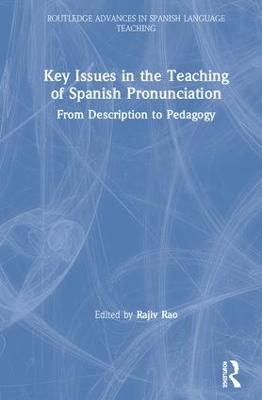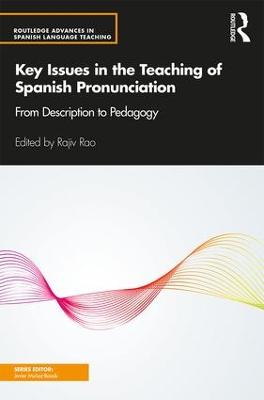Key Issues in the Teaching of Spanish Pronunciation
 -10%
portes grátis
-10%
portes grátis
Key Issues in the Teaching of Spanish Pronunciation
From Description to Pedagogy
Rao, Rajiv
Taylor & Francis Ltd
05/2019
356
Dura
Inglês
9781138954601
15 a 20 dias
680
Descrição não disponível.
Introduction
Rajiv Rao
Part I
The Sound System of Spanish
1 Description of Spanish Vowels and Guidelines for Teaching Them
Eugenio Martinez Celdran and Wendy Elvira-Garcia
2 Pronunciation in the L2 Spanish Classroom: The Voiceless Stops /p, t, k/
Mary L. Zampini
3 Suggestions for Teaching Spanish Voiced Stops /b, d, ?/ and Their Lenited Allophones [??, ??, ??]
Manuela Gonzalez-Bueno
4 A Theoretical Framework in the Acquisition and Teaching of Fricatives to L2 Learners of Spanish
A. Raymond Elliott
5 Issues in the Teaching of Spanish Liquid Consonants
Benjamin Schmeiser
6 The Polymorphism of Spanish Nasal Stops
Carlos-Eduardo Pineros
7 Incorporating Syllable Structure into the Teaching of Spanish Pronunciation
Sonia Colina
8 Improving Non-Native Pronunciation: Teaching Prosody to Learners of Spanish as a Second/Foreign Language
Carme de-la-Mota
Part II
Pedagogical Challenges and Suggestions for the Classroom
9 Spanish Pronunciation and Teaching Dialectal Variation
German Zarate-Sandez
10 Incorporating Technology into the Teaching of Spanish Pronunciation
Gillian Lord
11 Navigating Orthographic Issues in the Teaching of Spanish Pronunciation
Yasaman Rafat and Scott James Perry
12 The Role of Perception in Learning Spanish Pronunciation
C. Elizabeth Goodin-Mayeda
13 An Analytical Approach to Teaching Spanish Pronunciation to Native Speakers of German: First Language and Age of First Exposure as Crucial Factors
Conxita Lleo and Marta Ulloa
14 Teaching Pronunciation to Spanish Heritage Speakers
Amanda Boomershine and Rebecca Ronquest
15 Spanish Pronunciation and Teacher Training: Challenges and Suggestions
Manuel Delicado Cantero, William Steed, and Alfredo Herrero de Haro
Glossary
Rajiv Rao
Part I
The Sound System of Spanish
1 Description of Spanish Vowels and Guidelines for Teaching Them
Eugenio Martinez Celdran and Wendy Elvira-Garcia
2 Pronunciation in the L2 Spanish Classroom: The Voiceless Stops /p, t, k/
Mary L. Zampini
3 Suggestions for Teaching Spanish Voiced Stops /b, d, ?/ and Their Lenited Allophones [??, ??, ??]
Manuela Gonzalez-Bueno
4 A Theoretical Framework in the Acquisition and Teaching of Fricatives to L2 Learners of Spanish
A. Raymond Elliott
5 Issues in the Teaching of Spanish Liquid Consonants
Benjamin Schmeiser
6 The Polymorphism of Spanish Nasal Stops
Carlos-Eduardo Pineros
7 Incorporating Syllable Structure into the Teaching of Spanish Pronunciation
Sonia Colina
8 Improving Non-Native Pronunciation: Teaching Prosody to Learners of Spanish as a Second/Foreign Language
Carme de-la-Mota
Part II
Pedagogical Challenges and Suggestions for the Classroom
9 Spanish Pronunciation and Teaching Dialectal Variation
German Zarate-Sandez
10 Incorporating Technology into the Teaching of Spanish Pronunciation
Gillian Lord
11 Navigating Orthographic Issues in the Teaching of Spanish Pronunciation
Yasaman Rafat and Scott James Perry
12 The Role of Perception in Learning Spanish Pronunciation
C. Elizabeth Goodin-Mayeda
13 An Analytical Approach to Teaching Spanish Pronunciation to Native Speakers of German: First Language and Age of First Exposure as Crucial Factors
Conxita Lleo and Marta Ulloa
14 Teaching Pronunciation to Spanish Heritage Speakers
Amanda Boomershine and Rebecca Ronquest
15 Spanish Pronunciation and Teacher Training: Challenges and Suggestions
Manuel Delicado Cantero, William Steed, and Alfredo Herrero de Haro
Glossary
Este título pertence ao(s) assunto(s) indicados(s). Para ver outros títulos clique no assunto desejado.
Pe Rr;pedagogical practices;L2 Pronunciation;language acquisition;Pronunciation Instruction;Spanish phonetics;L2 Spanish;Spanish Pronunciation;VOT Duration;Heritage Spanish Speakers;L2 Learner;Spanish Language;English L2 Learner;Intonational Phrases;Nasal Place Assimilation;Differential Markedness Hypothesis;L2 Spanish Speaker;Heritage Speakers;Pace Model;L1 German Learner;L2 Phonological Acquisition;L2 Spanish Classroom;TL Sound;Vocal Cord Vibration;L1 English Speaker;Lateral Approximant;Spanish Vowels;Phonological Phrase
Introduction
Rajiv Rao
Part I
The Sound System of Spanish
1 Description of Spanish Vowels and Guidelines for Teaching Them
Eugenio Martinez Celdran and Wendy Elvira-Garcia
2 Pronunciation in the L2 Spanish Classroom: The Voiceless Stops /p, t, k/
Mary L. Zampini
3 Suggestions for Teaching Spanish Voiced Stops /b, d, ?/ and Their Lenited Allophones [??, ??, ??]
Manuela Gonzalez-Bueno
4 A Theoretical Framework in the Acquisition and Teaching of Fricatives to L2 Learners of Spanish
A. Raymond Elliott
5 Issues in the Teaching of Spanish Liquid Consonants
Benjamin Schmeiser
6 The Polymorphism of Spanish Nasal Stops
Carlos-Eduardo Pineros
7 Incorporating Syllable Structure into the Teaching of Spanish Pronunciation
Sonia Colina
8 Improving Non-Native Pronunciation: Teaching Prosody to Learners of Spanish as a Second/Foreign Language
Carme de-la-Mota
Part II
Pedagogical Challenges and Suggestions for the Classroom
9 Spanish Pronunciation and Teaching Dialectal Variation
German Zarate-Sandez
10 Incorporating Technology into the Teaching of Spanish Pronunciation
Gillian Lord
11 Navigating Orthographic Issues in the Teaching of Spanish Pronunciation
Yasaman Rafat and Scott James Perry
12 The Role of Perception in Learning Spanish Pronunciation
C. Elizabeth Goodin-Mayeda
13 An Analytical Approach to Teaching Spanish Pronunciation to Native Speakers of German: First Language and Age of First Exposure as Crucial Factors
Conxita Lleo and Marta Ulloa
14 Teaching Pronunciation to Spanish Heritage Speakers
Amanda Boomershine and Rebecca Ronquest
15 Spanish Pronunciation and Teacher Training: Challenges and Suggestions
Manuel Delicado Cantero, William Steed, and Alfredo Herrero de Haro
Glossary
Rajiv Rao
Part I
The Sound System of Spanish
1 Description of Spanish Vowels and Guidelines for Teaching Them
Eugenio Martinez Celdran and Wendy Elvira-Garcia
2 Pronunciation in the L2 Spanish Classroom: The Voiceless Stops /p, t, k/
Mary L. Zampini
3 Suggestions for Teaching Spanish Voiced Stops /b, d, ?/ and Their Lenited Allophones [??, ??, ??]
Manuela Gonzalez-Bueno
4 A Theoretical Framework in the Acquisition and Teaching of Fricatives to L2 Learners of Spanish
A. Raymond Elliott
5 Issues in the Teaching of Spanish Liquid Consonants
Benjamin Schmeiser
6 The Polymorphism of Spanish Nasal Stops
Carlos-Eduardo Pineros
7 Incorporating Syllable Structure into the Teaching of Spanish Pronunciation
Sonia Colina
8 Improving Non-Native Pronunciation: Teaching Prosody to Learners of Spanish as a Second/Foreign Language
Carme de-la-Mota
Part II
Pedagogical Challenges and Suggestions for the Classroom
9 Spanish Pronunciation and Teaching Dialectal Variation
German Zarate-Sandez
10 Incorporating Technology into the Teaching of Spanish Pronunciation
Gillian Lord
11 Navigating Orthographic Issues in the Teaching of Spanish Pronunciation
Yasaman Rafat and Scott James Perry
12 The Role of Perception in Learning Spanish Pronunciation
C. Elizabeth Goodin-Mayeda
13 An Analytical Approach to Teaching Spanish Pronunciation to Native Speakers of German: First Language and Age of First Exposure as Crucial Factors
Conxita Lleo and Marta Ulloa
14 Teaching Pronunciation to Spanish Heritage Speakers
Amanda Boomershine and Rebecca Ronquest
15 Spanish Pronunciation and Teacher Training: Challenges and Suggestions
Manuel Delicado Cantero, William Steed, and Alfredo Herrero de Haro
Glossary
Este título pertence ao(s) assunto(s) indicados(s). Para ver outros títulos clique no assunto desejado.
Pe Rr;pedagogical practices;L2 Pronunciation;language acquisition;Pronunciation Instruction;Spanish phonetics;L2 Spanish;Spanish Pronunciation;VOT Duration;Heritage Spanish Speakers;L2 Learner;Spanish Language;English L2 Learner;Intonational Phrases;Nasal Place Assimilation;Differential Markedness Hypothesis;L2 Spanish Speaker;Heritage Speakers;Pace Model;L1 German Learner;L2 Phonological Acquisition;L2 Spanish Classroom;TL Sound;Vocal Cord Vibration;L1 English Speaker;Lateral Approximant;Spanish Vowels;Phonological Phrase







